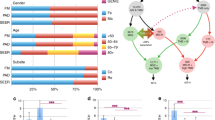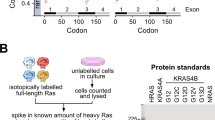Abstract
Genes of the RAF family encode kinases that are regulated by Ras and mediate cellular responses to growth signals. Activating mutations in one RAF gene, BRAF, have been found in a high proportion of melanomas and in a small fraction of other cancers1. Here we show that BRAF mutations in colorectal cancers occur only in tumours that do not carry mutations in a RAS gene known as KRAS, and that BRAF mutation is linked to the proficiency of these tumours in repairing mismatched bases in DNA. Our results not only provide genetic support for the idea that mutations in BRAF and KRAS exert equivalent effects in tumorigenesis2, but also emphasize the role of repair processes in establishing the mutation spectra that underpin human cancer.
Similar content being viewed by others
Main
To determine how alterations in BRAF and KRAS might affect one another, we systematically evaluated mutations in these genes in 330 colorectal tumours (Table 1). We identified 32 mutations in BRAF: 28 cases with thymine-to-adenine (T–A) transversions at nucleotide position 1,796 (corresponding to an amino-acid swap of glutamate for valine at residue 599; V599E), and one case each of a guanine-to-thymine (G–T) transversion at nucleotide 1,382 (R461I), a T–G transversion at nucleotide 1,385 (I462S), a G–A transition at nucleotide 1,388 (G463E), and an A–G transition at nucleotide 1,798 (K600E). All but two of these mutations seemed to be heterozygous, and in all 20 cases for which normal tissue was available, the mutations were shown to be somatic. In the same set of tumours, there were 169 mutations in KRAS, including alterations to codons 12, 13, 59 and 61. No tumour exhibited mutations in both BRAF and KRAS.
Mutations in either BRAF or KRAS occurred in all Duke's stages of cancer (results not shown) and also in premalignant lesions. Mutations in both genes seemed to be more common in adenomas larger than 1 cm across than they were in smaller adenomas.
There was also a striking difference in the frequency of BRAF mutations between cancers with and without mismatch-repair (MMR) deficiency (P < 10−6, χ2 test; Table 1). All but one of the 15 BRAF mutations identified in MMR-deficient cases resulted in a V599E substitution.
These results provide strong support for the hypothesis that BRAF and KRAS mutations are equivalent in their tumorigenic effects2. Both genes seem to be mutated at a similar phase of tumorigenesis, after initiation but before malignant conversion. Moreover, we found no tumour that concurrently contained both BRAF and KRAS mutations. In view of the large number of mutations of both genes found in colorectal cancers, this observation is highly statistically significant (P < 10−6, χ2-test) and cannot be easily explained in other ways. This conclusion could not have been reached through the study of melanomas or of most other tumour types in which only one of the two genes is commonly mutated. It is consistent with biochemical observations3 and was suggested by Davies et al.1.
Our results also show that MMR-deficient tumours have a very high incidence of BRAF mutations and a lower incidence of KRAS mutations compared with MMR-proficient colorectal cancers. This is consistent with the idea that both tumour types progress through the same biochemical pathways, but that the mutation spectrum depends on the nature of the underlying genetic instability4. The V599E mutation is the most frequent nucleotide substitution ever identified in a repair-deficient tumour.
The only other tumour type with a BRAF-mutation frequency as high as that seen in MMR-deficient colorectal cancers is melanoma1. Melanomas and MMR-deficient colorectal cancers also share a high incidence of mutations in the oncogene that encodes β-catenin5,6. It will be interesting to see whether melanomas have a repair defect that makes them susceptible to the types of mutation found in MMR-deficient colorectal cancers, and to determine what structural or sequence elements surrounding BRAF codon 599 make it prone to mutagenesis in a repair-deficient background.
References
Davies, H. et al. Nature 417, 949–954 (2002).
Storm, S. M. & Rapp, U. R. Toxicol. Lett. 67, 201–210 (1993).
Marais, R., Light, Y., Paterson, H. F., Mason, C. S. & Marshall, C. J. J. Biol. Chem. 272, 4378–4383 (1997).
Kinzler, K. W. & Vogelstein, B. Cell 87, 159–170 (1996).
Sparks, A. B., Morin, P. J., Vogelstein, B. & Kinzler, K. W. Cancer Res. 58, 1130–1134 (1998).
Rubinfeld, B. et al. Science 275, 1790–1792 (1997).
Thiagalingam, S. et al. Proc. Natl Acad. Sci. USA 98, 2698–2702 (2001).
Wang, T. L. et al. Proc. Natl Acad. Sci. USA 99, 3076–3080 (2002).
Markowitz, S. J. Clin. Oncol. 18 (suppl.), 75–80 (2000).
Author information
Authors and Affiliations
Corresponding author
Ethics declarations
Competing interests
The authors declare no competing financial interests.
Rights and permissions
About this article
Cite this article
Rajagopalan, H., Bardelli, A., Lengauer, C. et al. RAF/RAS oncogenes and mismatch-repair status. Nature 418, 934 (2002). https://doi.org/10.1038/418934a
Issue Date:
DOI: https://doi.org/10.1038/418934a
This article is cited by
-
Opposing roles by KRAS and BRAF mutation on immune cell infiltration in colorectal cancer – possible implications for immunotherapy
British Journal of Cancer (2024)
-
Anoikis resistance––protagonists of breast cancer cells survive and metastasize after ECM detachment
Cell Communication and Signaling (2023)
-
Coincidence of primary adrenocortical carcinoma and melanoma: three CASE reports
BMC Endocrine Disorders (2023)
-
Targeted exome-based predictors of patterns of progression of colorectal liver metastasis after percutaneous thermal ablation
British Journal of Cancer (2023)
-
Management of Microsatellite Instability High (MSI-H) Gastroesophageal Adenocarcinoma
Journal of Gastrointestinal Cancer (2023)
Comments
By submitting a comment you agree to abide by our Terms and Community Guidelines. If you find something abusive or that does not comply with our terms or guidelines please flag it as inappropriate.



